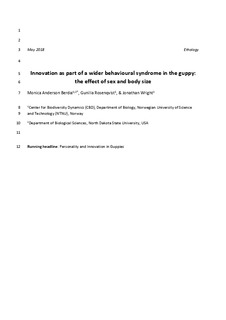| dc.contributor.author | Berdal, Monica Anderson | |
| dc.contributor.author | Rosenqvist, Gunilla | |
| dc.contributor.author | Wright, Jonathan | |
| dc.date.accessioned | 2019-04-02T13:53:30Z | |
| dc.date.available | 2019-04-02T13:53:30Z | |
| dc.date.created | 2018-10-12T10:16:04Z | |
| dc.date.issued | 2018 | |
| dc.identifier.citation | Ethology. 2018, 124 (10), 760-772. | nb_NO |
| dc.identifier.issn | 0179-1613 | |
| dc.identifier.uri | http://hdl.handle.net/11250/2592992 | |
| dc.description.abstract | Recent work on animal personalities has shown that individuals within populations often differ consistently in various types of behaviour and that many of these behaviours correlate among individuals to form behavioural syndromes. Individuals of certain species have also been shown to differ in their rate of behavioural innovation in arriving at novel solutions to new and existing problems (e.g., mazes, novel foods). Here, we investigate whether behaviours traditionally studied in personality research are correlated with individual rates of innovation as part of a wider behavioural syndrome. Guppies (Poecilia reticulata) of both sexes from three different wild population sources were assessed: (a) exploration of an open area; (b) speed through a three‐dimensional maze; (c) investigation of a novel object; and (d) attraction to a novel food. The covariance structure (syndrome structure) was examined using structural equation modelling. The best model separated behaviours relating to activity in all contexts from rates of exploration/investigation and innovation. Innovative behaviour (utilizing new food and moving through a novel area) in these fish therefore forms part of the same syndrome as the traditional shy‐bold continuum (exploration of an open area and investigation of a novel object) found in many animal personality studies. There were no clear differences in innovation or syndrome structure between the sexes, or between the three different populations. However, body size was implicated as part of the behavioural syndrome structure, and because body size is highly correlated with age in guppies, this suggests that individual behavioural differences in personality/innovation in guppies may largely be driven by developmental state. | nb_NO |
| dc.language.iso | eng | nb_NO |
| dc.publisher | Wiley | nb_NO |
| dc.title | Innovation as part of a wider behavioural syndrome in the guppy: The effect of sex and body size | nb_NO |
| dc.type | Journal article | nb_NO |
| dc.type | Peer reviewed | nb_NO |
| dc.description.version | acceptedVersion | nb_NO |
| dc.source.pagenumber | 760-772 | nb_NO |
| dc.source.volume | 124 | nb_NO |
| dc.source.journal | Ethology | nb_NO |
| dc.source.issue | 10 | nb_NO |
| dc.identifier.doi | 10.1111/eth.12810 | |
| dc.identifier.cristin | 1619911 | |
| dc.description.localcode | Locked until 11.9.2019 due to copyright restrictions. This is the peer reviewed version of an article, which has been published in final form at [https://doi.org/10.1111/eth.12810]. This article may be used for non-commercial purposes in accordance with Wiley Terms and Conditions for Self-Archiving. | nb_NO |
| cristin.unitcode | 194,66,10,0 | |
| cristin.unitname | Institutt for biologi | |
| cristin.ispublished | true | |
| cristin.fulltext | preprint | |
| cristin.qualitycode | 1 | |
